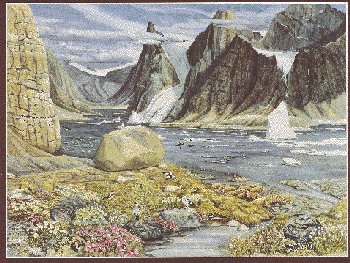Ice and rock reign supreme in the Arctic Cordillera Ecozone, an area featuring some of the world's most spectacular mountain glacial scenery. Massive ice caps and tonguing glaciers mask many of the rugged mountains. Some of Canada's highest but least-known peaks are found here, towering over gaping U-shaped valleys and deep fiords that extend many kilometres inland.
A vast mountain chain forms the spine of this ecozone. It runs along the northeastern fringe of the Northwest Territories and Labrador, dominating Labrador, eastern Baffin, and Devon islands and most of Ellesmere and Bylot islands. Because of the extreme cold, high winds, and lack of soil, the higher portions of this ecozone are largely devoid of plants and animals. Ice barrens and frost-shattered rock prevail over much of the landscape.
At lower elevations, pockets of tundra meadow dotted with arctic flowers and ground-hugging shrubs occupy sheltered valleys, streambanks and coastlines. During the brief arctic summer, these sites are oases of concentrated life.
In contrast to the biological impoverishment of the land, the adjacent fiords and nearshore waters are richly endowed with marine life. Complex current systems, localized upwellings of nutrients, and “polynyas” (which remain ice-free year round) create the Arctic's most productive aquatic ecosystems. Among the animals living here are globally significant populations of Polar Bear, Narwhal Whale, and the endangered Bowhead Whale.
Although elements of the last ice age persist in the Arctic Cordillera, the region is a land of surprising vitality. Even the ice itself can come alive to the eyes and ears of patient observers.
